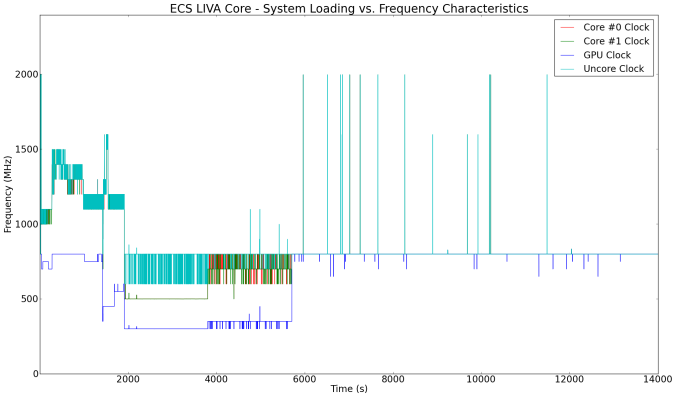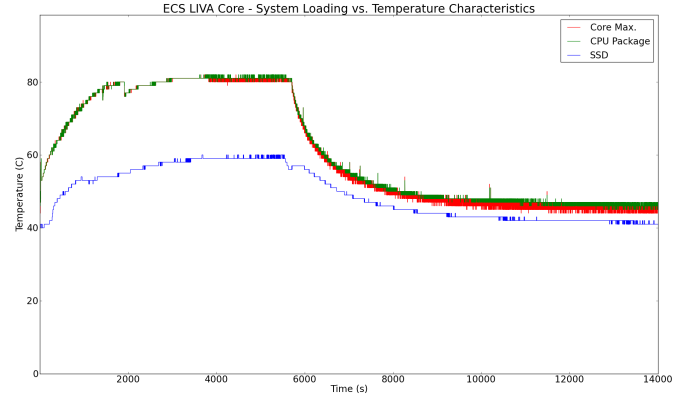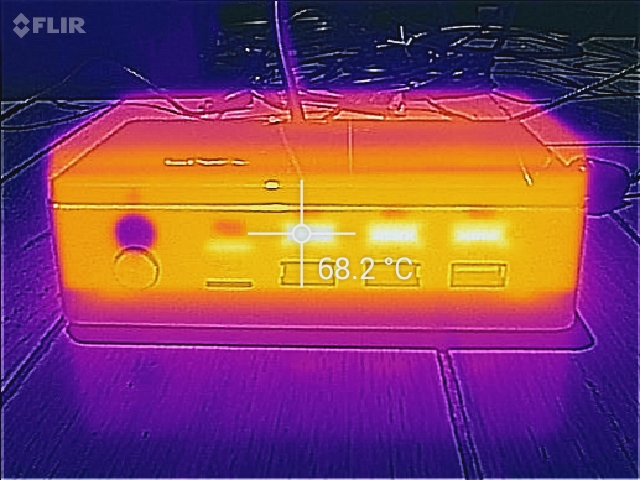ECS LIVA Core Review: A Fanless Core M mini-PC
by Ganesh T S on October 7, 2015 8:00 AM ESTPower Consumption and Thermal Performance
The power consumption at the wall was measured with a 1080p display being driven through one of the HDMI ports. In the graphs below, we compare the idle and load power of the ECS LIVA Core with other low power PCs evaluated before. For load power consumption, we ran Furmark 1.12.0 and Prime95 v27.9 together. In terms of idle power, only the ECS LIVA x2 with an Atom-class SoC platform is better.


On the full load side, we observed 17.44 W peak power consumption. However, this was in the turbo mode for less than 15 seconds. In the full load steady state, we observed the power consumption to be around 10.1 W - the lowest of any mini-PC that we have evaluated so far.
Our thermal stress routine starts with the system at idle, followed by 30 minutes of pure CPU loading. This is followed by another 30 minutes of both CPU and GPU being loaded simultaneously. After this, the CPU load gets removed, allowing the GPU to be loaded alone for another 30 minutes. The various clocks in the system as well as the temperatures within the unit are presented below. In the first graph, we can see the small spike to 2 GHz for the core clocks very early on in the evaluation routine. The cores drop down to 1 GHz, but later on move to 1.5 GHz for a while before settling down around 1.2 GHz. However, introduction of additional GPU load forces the cores to operate between 600 and 800 MHz, while the GPU staus at 300 MHz. Removal of the CPU load allows the GPU to go up to 350 MHz under sustained loading conditions.
According to the official specifications, the junction temperature of the Core M 5Y10c is 95 C. The maximum core temperature recorded in the course of our thermal evaluation routine was only around 80 C - indicating that the thermal solution is good enough for the platform.
Another important aspect to keep note of while evaluating fanless PCs is the chassis temperature. Using the Android version of the FLIR One thermal imager, we observed the chassis temperature after the CPU package temperature reached the steady state value in the above graph.
We have additional thermal images in the gallery below.
A chassis temperature of around 68 C is definitely a bit too hot to handle, but, thankfully, it is not as bad as the 75 C we saw in the LIVA X2. The metal base at the bottom as well as the substantially better heat sink on top of the SoC manage to keep the temperature of the system under better limits. However, the chassis design could definitely do with some improvements to make this aspect better.



















35 Comments
View All Comments
Pissedoffyouth - Wednesday, October 7, 2015 - link
What's the Linux support like? I'd want one to use as a main desktop PCJaybus - Wednesday, October 7, 2015 - link
The relatively new AC 3165 WLAN chip is supported in kernels 4.1+. With older kernels an Intel driver will be needed. I'm not sure of the exact minimum kernel version that the Intel driver supports. All of the other hardware should be supported in recent distros.WJames65 - Wednesday, October 7, 2015 - link
Nice to see Anandtech providing small footprint "mini PC" reviews. I just ordered a MSI cube with a Broadwell CPU. To the user who noted no H.265 support, Intel added driver support to Haswell and Broadwell months ago. The author of this review didn't mention H.265 support, and did not test it. Perhaps, another review or an update will include H.265 testing.ganeshts - Wednesday, October 7, 2015 - link
Please note the final paragraph in the HTPC Aspects section. HEVC decode (even hybrid acceleration) is NOT supported in the Broadwell Core M SKUs.WJames65 - Wednesday, October 7, 2015 - link
Yeah, I see that line in the HTPC section. However, Intel says otherwise: http://techreport.com/news/27677/new-intel-igp-dri...WJames65 - Wednesday, October 7, 2015 - link
This is interesting... According to Intel, only those CPUs with Iris 5500 or later have hardware accelerated H.265. Glad my mini-PC has such a GPU. :) See here: https://communities.intel.com/thread/59216Bob Todd - Wednesday, October 7, 2015 - link
I replaced a much larger HTPC with one of the cheap and tiny ECS LIVA units (dual core Bay Trail-M, gigabit ethernet, HDMI, 2GB RAM, 32GB emmc). For $99 it has proven to be a great little streamer for the modest needs in our bedroom. Low tdp. No fan . No blinding blue LEDs to disconnect.Einy0 - Wednesday, October 7, 2015 - link
I've been using the same unit in my living room for about a year now. The latest release of Windows 10 insider has nearly broken the Netflix app completely. I may have to move on to another platform or go back to Windows 8.1.Pissedoffyouth - Wednesday, October 7, 2015 - link
And what did we learn today about using alpha software?Gigaplex - Thursday, October 8, 2015 - link
Windows 10 insider program is not alpha. It's more like a cross between beta and release candidate.